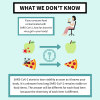Can COVID-19 be transmitted through food?
[Authors: Bridget O'Brien is a 4th year undergraduate student in the Faculty of Science (Microbiology & Immunology), and an Honours student with Dr Ronholm. This paper stems from her NSERC USRA research project with Dr Ronholm in the summer 2020; Dr Jennifer Ronholm is an Assistant Professor in both the Departments of Animal Science and Food Science, whose research focuses on the microbiome of food-producing animals]
* To date there has not been a reported case of COVID-19 that was acquired from food *
Respiratory viruses such as influenza or COVID-19, are known to be spread primarily through respiratory droplets – one person breathes or sneezes, and another person is exposed by breathing in the virus. Self-contamination can also take place if an uninfected person touches their eyes, nose or mouth with respiratory secretions from an infected person.
There are ongoing questions about possible foodborne transmission of respiratory viruses such as COVID-19 or influenza A, especially H5N1 avian influenza virus (AIV). In theory, respiratory viruses could be deposited on food items and transmitted via consumption after the virus reaches permissive tissue in the throat, or if the virus survives to the intestinal tract, it could infect permissive cells in this environment and spread systemically.
(See graphic 1)
A recently-published article Exploring the potential of foodborne transmission of respiratory viruses, by Bridget O'Brien, Lawrence Goodridge, Jennifer Ronholm, and Neda Nasheri, summarizes the evidence for and against possible foodborne transmission of several respiratory viruses, including SARS-CoV-2 (COVID-19) and other closely related coronaviruses including MERS-CoV and SADS-CoV. While there are observations that support a theoretical possibility of foodborne transmission, including expression of the ACE2 receptor on intestinal cells – there are currently no recorded cases of COVID-19 that have clearly been acquired from food, nor are there outbreaks that would indicate a food source. Therefore, the authors conclude that foodborne transmission – while theoretically possible – is unlikely.
(See graphic 2)
It is worth noting that several people diagnosed with COVID-19 have no known epidemiological link to a known case. These people are not asked about food consumption, so if a small number of cases were linked to food, they may go undetected.
There are still some things that we don’t know about SARS-CoV-2 that are important in understanding its relationship with food. The most important of which are how long the virus maintains viability on food items, and what happens to the live virus within the human gastrointestinal tract if it gets there. These two questions are important to address as we increase our understanding of this pathogen.
(See graphic 3)
At the moment, food is not thought to be a vector for transmission of SARS-CoV-2, and the recommended practices for maintaining the safety of food items – hand-washing, properly washing fruits and vegetables with warm water, cooking meat properly, and not handling food items for other’s consumption while one is experiencing symptoms of any infectious disease – should be adequate for SARS-CoV-2.


